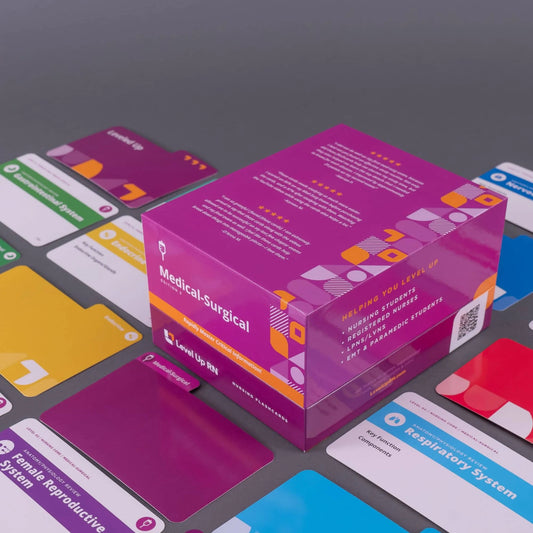In this article, we explain the components of blood and how blood clotting works.
The Med-Surg Nursing video series follows along with our Medical-Surgical Nursing Flashcards, which are intended to help RN and PN nursing students study for nursing school exams, including the ATI, HESI, and NCLEX.
Blood components
Blood in the human body comprises plasma and formed elements, including red blood cells, white blood cells, and platelets.
Plasma
Plasma in blood contains water, ions, protein (albumin, globulin, fibrinogen, clotting factors), nutrients, wastes, and gasses.
Formed Elements
The formed elements in blood are red blood cells, white blood cells, and platelets.
Red blood cells (erythrocytes)
The body's red blood cells, or erythrocytes carry oxygen and remove carbon dioxide. This is also covered in our Respiratory overview.
White blood cells (leukocytes)
The body's white blood cells, or leukocytes, are part of the body’s immune system, and their purpose is to detect and fight off pathogens.
Platelets (thrombocytes)
Platelets in blood are instrumental in the blood clotting process. Thromboycytopenia is a condition wherein the blood doesn't have enough platelets which can put a patient at a high risk for bleeding. We'll cover the blood clotting process next!
Hemostasis
Hemostasis means blood clotting. In your med-surg classes, you'll need to be aware of both primary and secondary hemostasis.
Primary Hemostasis
The process of primary hemostasis begins when vascular injury causes vasoconstriction, platelet aggregation and formation of a platelet plug. This then triggers secondary hemostasis.
Secondary Hemostasis
During secondary hemostasis, clotting factors 1-13 activate each other in a clotting cascade. As Cathy explains in the video, you may have to know all thirteen of these factors in a physiology class, but you may not need to in nursing school. Check with your program.
Within secondary hemostasis, there is the intrinsic pathway, extrinsic pathway, and a common pathway.
Intrinsic pathway
The intrinsic pathway in secondary hemostasis is the activation of clotting factors inside the blood in response to blood vessel damage. The intrinsic pathway is measured as activated partial thromboplastin time (aPTT).
Extrinsic pathway
The extrinsic pathway in secondary hemostasis is the activation of clotting factors outside the blood, in response to trauma to extravascular cells. The extrinsic pathway is measured as prothrombin time (PT).
Common pathway
The common pathway in secondary hemostasis is when the Intrinsic and extrinsic pathways merge together.. Prothrombin is activated into thrombin, which activates fibrinogen into fibrin (clot).
The key takeaway from this information is that hemostasis involves platelets as well as clotting factors. So when we explore coagulation disorders later in this series, you'll see that some of those coagulation disorders are caused by a lack of platelets, and other coagulation disorders are caused by a lack of clotting factors.


